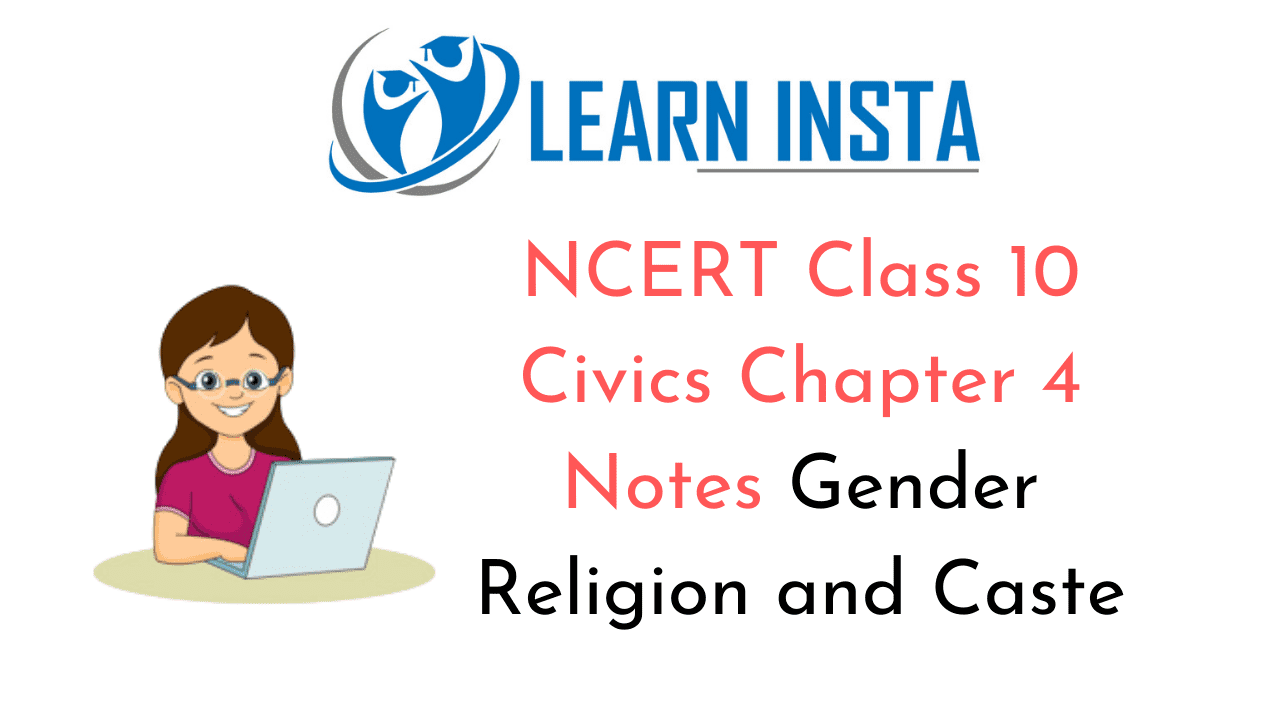 On this page, you will find NCERT Class 10 Civics Chapter 4 Notes Pdf free download. CBSE Class 10 Social Science Notes Civics Chapter 4 SST Gender Religion and Caste will seemingly, help them to revise the important concepts in less time.
On this page, you will find NCERT Class 10 Civics Chapter 4 Notes Pdf free download. CBSE Class 10 Social Science Notes Civics Chapter 4 SST Gender Religion and Caste will seemingly, help them to revise the important concepts in less time.
Gender Religion and Caste Class 10 Notes Social Science Civics Chapter 4
CBSE Class 10 Civics Chapter 4 Notes Understanding the Lesson
1. Three kinds of social differences that can take the form of social divisions and inequalities are – gender, religion and caste.
2. Gender division is a form of hierarchical social division seen everywhere, but is rarely recognized in the study of politics. Gender division is not based on biology but on social expectations and stereotypes.
3. Boys and girls are brought up to believe that the main responsibility of women is housework and bringing up children. This is reflected in the sexual division of labour in most families- women work inside the home and men do all the work outside the house.
4. Although women constitute half of the humanity, their role in public life is very small in most societies. However, political expression of gender division and political mobilization on this question have improved women’s role in public role. We have now women scientists, doctors, etc.
5. In countries like Sweden, Norway and Finland, the participation of women in public life is very high. But it is not so in our country which is still a male-dominated society.
6. In India, only a smaller proportion of girl students go for higher studies. The proportion of women among the highly paid and valued jobs is also very small. In many parts of India parents still prefer sons and find ways to abort girl child before she is born.
7. Gender division needs to be expressed in politics for the benefit of the women. The unequal treatment that they are getting should be raised in the political domain.
8. Social division based on religious differences is not as universal as gender, but we can see religious diversity almost everywhere. Many countries including India have in their population, followers of different religions. Hence, religious differences are often expressed in the field of politics.
9. Communal politics takes place when beliefs of one religion are presented as superior to those of other religions and when state power is used to establish domination of one religious group over the rest.
10. A communal mind often leads to a quest for political dominance of one’s own religious community. Political mobilization on religious lines is another form of communalism. This involves the use of sacred symbols, religious leaders, emotional appeal, and plain fear in order to bring the followers of one religion together in the political arena.
11. Sometimes communalism takes its most ugly form of communal violence, riots and massacre. Communalism, therefore, continues to be one of the major challenges to democracy in our country. The makers of our Constitution were aware of this challenge. That is why they chose the model of a secular state.
12. There is no official religion for the Indian state. The Constitution prohibits discrimination on grounds of religion. Everyone is free to follow the religion of his/her choice.
13. Caste system in India was based on exclusion of and discrimination against the outcast groups. They were subjected to the inhuman practice of untouchability.
14. Political leaders and social reformers like Jotiba Phule, Gandhiji, Ambedkar, etc. made serious efforts to establish a society in which caste inequalities are absent.
15. Although caste inequalities still exist in Indian societies, they are not seen in acute form today. With economic development, large scale urbanization, growth of literacy and education, the old notions of caste hierarchy are breaking down.
16 Casteism is rooted in the belief that caste is the sole basis of social community. Caste can take various form in politics:
- Political parties and candidates in elections make appeals to caste sentiment to muster supports.
- No party wins the votes of all the voters of a caste or community.
17. If caste influences electoral politics, politics too influences caste system and caste identities by bringing them into the political domain.
18. Each caste group tries to become bigger by incorporating within it neighboring castes or sub-castes which were earlier excluded from it.
19. New kinds of caste groups have come up in the political arena like ‘backward’ and ‘forward’ caste groups.
20. Caste plays different kinds of role in politics. In some situations, expression of caste differences in politics gives many disadvantaged communities the space to demand their share of power. Now Dalits and OBCs have gained better access to decision-making.
Gender Religion and Caste Class 10 CBSE Notes Important Terms
Feminist: A woman or a man who believes in equal rights and opportunities for women and men.
Patriarchy: This is a concept used to refer to a system that values men more and gives them power over women.
Casteism: Adherence to a caste system or prejudice or discrimination on the grounds of caste.
Secular: Not connected with religious or spiritual matters.
Gender: One’s sex (male or female).
Sex-ratio: Number of girl children per thousand boys.
Communal: (here) (of conflict) between different communities, especially those having different religious or ethnic groups.
Communalism: Allegiance to one’s own ethnic group rather than to the wider society.
Urbanization: Shift of population from rural areas to urban areas.